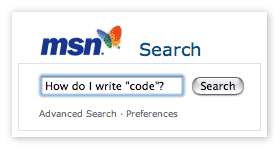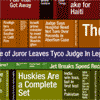 So I have this friend named Lavina who occasionally sends me e-mails and instant messages set in Comic Sans. I have told her repeatedly that this font has been officially banned, but she “just likes it” and continues to use it in various pieces of correspondence… even if it is just to piss me off.
So I have this friend named Lavina who occasionally sends me e-mails and instant messages set in Comic Sans. I have told her repeatedly that this font has been officially banned, but she “just likes it” and continues to use it in various pieces of correspondence… even if it is just to piss me off.
So that got me thinking, should a website allow you to explicitly set the typeface of what you’re reading? Most sites set the typeface for you. My site gives you several choices derived from what I find to be very readable faces: Lucida Grande, Verdana, Helvetica, etc. But what about the edge case that just really loves Comic Sans? Should I throw Comic Sans in my dropdown menu on the right side of this site? Clearly not, unless I want to be publicly ridiculed at work.
What I decided to try instead was adding a custom font field to the Readability section on the right side of this site. Click the “Or, specify your own…” link and type in any font you have installed on your system. Then, hit the “Set” button and voila! Mike Industries will reluctantly render in whatever twisted typeface you happen to think of that day. Even Comic Sans. Or worse yet, Giddyup (see picture above). The only downside is that you need to type the font name in exactly as your system labels it. So for instance, on the Mac, “ComicSansMS” works but “Comic Sans” does not. If you have a particular font you’d like to specify, just try a few variations of its name, with and without spaces, and you’ll get it after a few tries. If you don’t get it, the site will just render in whatever your default font is.
One thing I’d really like to be able to do with this is have a dropdown menu with all the fonts a user has installed instead of making people type a font name in. Does anybody have any idea if this is possible? My suspicion is that if it is, it may require writing something OS-specific… bad.
So for now, please enjoy the Custom Font Selector, and let me know if you have any ideas to improve it. I feel like this functionality is best suited for OS X users right now because we get to view true anti-aliased Postscript fonts in our browsers, but as mentioned with regard to Comic Sans, Windows users can “benefit” too.
 Little ESPN Malachi McCall turns three years old next month. The smiling boy from Pampa, Texas, pictured on the right, will be getting a visit from us as part of a two-hour ESPN25 television special in which he and two other youngsters named after the network will be featured.
Little ESPN Malachi McCall turns three years old next month. The smiling boy from Pampa, Texas, pictured on the right, will be getting a visit from us as part of a two-hour ESPN25 television special in which he and two other youngsters named after the network will be featured. Well it’s about half past midnight right now and it looks like Bloglines just relaunched a few minutes ago with a
Well it’s about half past midnight right now and it looks like Bloglines just relaunched a few minutes ago with a  Today marked the launch of Microsoft’s vaunted new MSN Search site. The new
Today marked the launch of Microsoft’s vaunted new MSN Search site. The new  Jason Shellen, of Google,
Jason Shellen, of Google,  Everyone does visited links differently. Jakob Neilson flunkies use the old school blue-and-purple combo to help show visitors where they’ve been. People with actual design taste use more palatable colors, or perhaps a font-weight variation instead. When Mike Industries launched, visited links differentiated themselves with a
Everyone does visited links differently. Jakob Neilson flunkies use the old school blue-and-purple combo to help show visitors where they’ve been. People with actual design taste use more palatable colors, or perhaps a font-weight variation instead. When Mike Industries launched, visited links differentiated themselves with a  Well it’s been a good first week here at Mike Industries. Over 50,000 page views, plenty of scathing editorial and healthy discussion in the comment threads, and not a single piece of hate mail! Not that readers might be interested in such things, but I thought I’d share some of the nuggets gleaned from
Well it’s been a good first week here at Mike Industries. Over 50,000 page views, plenty of scathing editorial and healthy discussion in the comment threads, and not a single piece of hate mail! Not that readers might be interested in such things, but I thought I’d share some of the nuggets gleaned from 
 I love Movable Type. I really do. But there are two things about it which really chap my hide. The first is that it doesn’t offer dynamic page serving, so I must recompile my entire site after making a change. I can live with this problem as recompiling is just a question of hitting a button and waiting awhile.
I love Movable Type. I really do. But there are two things about it which really chap my hide. The first is that it doesn’t offer dynamic page serving, so I must recompile my entire site after making a change. I can live with this problem as recompiling is just a question of hitting a button and waiting awhile. So I have this friend named Lavina who occasionally sends me e-mails and instant messages set in Comic Sans. I have told her repeatedly that
So I have this friend named Lavina who occasionally sends me e-mails and instant messages set in Comic Sans. I have told her repeatedly that  Information overload. It’s the next big issue in publishing, and technology in general. The day you have 400 e-mails in your inbox, 900 new items in your RSS aggregator, and 8 Instant Messenger windows on your screen will come. For some people, it’s already here.
Information overload. It’s the next big issue in publishing, and technology in general. The day you have 400 e-mails in your inbox, 900 new items in your RSS aggregator, and 8 Instant Messenger windows on your screen will come. For some people, it’s already here.